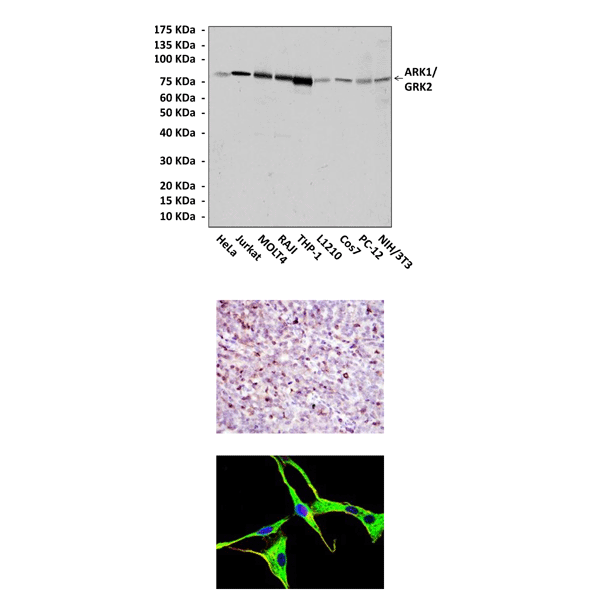Anti-ARK1/GRK2: Mouse ARK1/GRK2 Antibody |
 |
BACKGROUND Beta-Adrenergic Receptor Kinase (beta-ARK1), also known as GRK2, is a member of the Serine /Threonine G protein-coupled receptor kinase superfamily.1 It phosphorylates the beta-2-Adrenergic Receptors and appears to mediate agonist-specific desensitization observed at high agonist concentrations. This kinase is a ubiquitous cytosolic enzyme that regulates cardiac output and activity in response to catecholamines. It modulates beta-AR activity and abrogats beta-AR-dependent signals by directly phosphorylating the receptors.2 Amounts of beta-ARK1 are increased in cardiac disease, where cardiac output is below normal, suggesting that the impairment of beta-AR activity could lead to certain forms of heart disease. Thus, there is great interest in generating therapeutic agents that can modulate the activity of the beta-ARK1.3
REFERENCES
1. Rockman, H.A. et al: Nature 415:206-12, 2002
2. Hausdorff, W.P. et al: FASEB J. 4:2881-9, 1990
3. Hata, J.A. & Koch, W.J.: Mol. Intervent. 3:264-72, 2003
2. Hausdorff, W.P. et al: FASEB J. 4:2881-9, 1990
3. Hata, J.A. & Koch, W.J.: Mol. Intervent. 3:264-72, 2003
Products are for research use only. They are not intended for human, animal, or diagnostic applications.
Параметры
Cat.No.: | CP10374 |
Antigen: | Raised against purified recombinant fragments of human ARK1/GRK2 expressed in E. Coli. |
Isotype: | Mouse IgG1 |
Species & predicted species cross- reactivity ( ): | Human, Mouse, Rat |
Applications & Suggested starting dilutions:* | WB 1:1000 IP n/d IHC 1:50 - 1:200 ICC 1:50 - 1:200 FACS n/d |
Predicted Molecular Weight of protein: | 80 kDa |
Specificity/Sensitivity: | Detects ARK1/GRK2 proteins without cross-reactivity with other family members. |
Storage: | Store at -20°C, 4°C for frequent use. Avoid repeated freeze-thaw cycles. |
*Optimal working dilutions must be determined by end user.
Документы
Информация представлена исключительно в ознакомительных целях и ни при каких условиях не является публичной офертой








